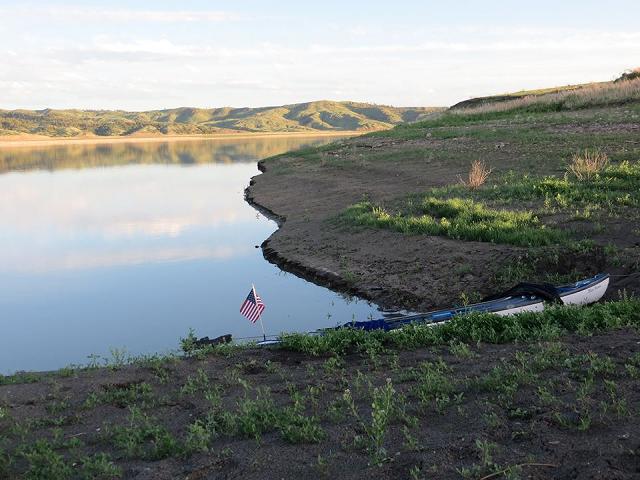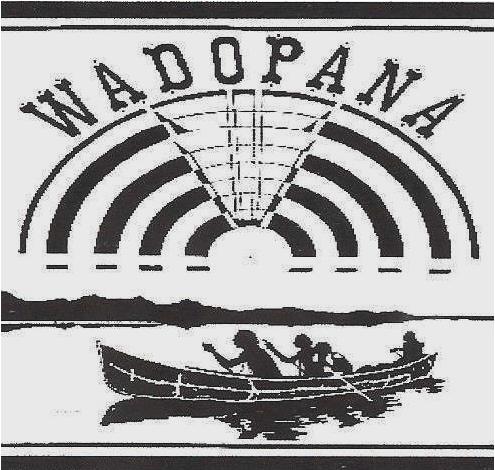 |
Canku Ota
|
 |
|
(Many Paths)
|
||
|
An Online Newsletter
Celebrating Native America
|
||
|
June 2017 - Volume 15
Number 6
|
||
|
|
||
|
Wadopana Canoe Journey
'Will Revive Part Of Our Culture'
|
||
|
by Richard Walker -
Indian Country Today
|
||
|
The history
of the Wadopana Nakoda still lives 'in bits and pieces'
with a reawakening about to take place
Since contact, the history of the Wadopana Nakoda people has been reinterpreted and rewritten by others, and the people have been attacked by disease, displacement and relocation to reservations. But the Wadopana Nakoda never forgot who they are, never forgot their ties to the water—how Iktomi created them and the land from mud from the bottom of the sea; how they traveled by canoe on their ancestral waters, what we know now as the Great Lakes. How their name, Wadopana (pronounced Wa-DOH-pa-nah), means "canoe paddler." Their history still lives "in bits and pieces," one leader wrote, and awaits a reawakening. The reawakening is near. Like the Northwest Canoe Journey, the Wadopana Canoe Journey will bring people together, teach young people about their culture, and give the elders a forum where they can teach and be listened to, said Ed Midkiff, a Suquamish Tribe carver who has relatives at Wadopana Nakoda. "With iPhones and other electronic devices, it's hard to teach young ones what their culture's about," Midkiff said. "You can't just say, 'Go outside and play' anymore. But with the canoe journey, they have fun going outside to play. They get out on the water and learn about their culture." The Northwest Canoe Journey, started in 1989, sparked a cultural revival – inspiring a new generation of canoe carvers, bringing back languages and protocols, and restoring traditional travel on ancestral waters – and the Wadopana Nakoda have the same expectations. "Participants will experience the revival of a canoe culture in the making," organizers wrote. "No one can remember the last Wadopana Nakoda canoe journey made as a people." Inspired by visit to Suquamish Planning for a Wadopana Canoe Journey began in 2011, and Midkiff carved and gifted a paddle that year that has been used in flag and paddle ceremonies since then. The Wadopana Canoe Journey, Morris said, "will revive part of our culture." Like the Northwest Canoe Journey, the Wadopana Canoe Journey will require mental, physical and spiritual discipline. Morris said pullers will start at Fort Peck Dam and travel east "50 miles as the crow flies" to Poplar. But the distance is much longer; the Missouri River curves and winds along the southern border of the Fort Peck Reservation. Pullers will navigate changes in currents, particularly where the river picks up the Milk and the Poplar. Like their Northwest counterparts, Wadopana Nakoda will find traveling the way of the ancestors will require respect, trust, and support for others in the canoe. "Every story is important. The bow, the stern, the skipper, the power puller in the middle – everyone is part of the movement," the Quileute Tribe's 10 Rules of the Canoe states. "The elder sits in her cedar at the front, singing her paddle song, praying for us all. The weary paddler resting is still ballast. And there is always that time when the crew needs some joke, some remark, some silence to keep going, and the least likely person provides." History tied to the water After contact, the Nakoda became known as Assiniboine, from the Ojibwe words u´sin i and u´pwawn´, meaning "stone boilers," because the Nakoda cooked by heating fist-size stones until red hot and then immersing them into hides of water, making the water boil for soups and stews. The Red Bottom, or Red Root, people derive their name from red plants that had colored the bottom of lodges, or from their reputation as keepers of medicines – "Hude´shabina, 'red roots' in our language," Inazhi wrote.
The people who wintered where the Milk River empties into the Missouri River were known as Wadopana, or canoe paddler, "because our people at one time used the canoe." When the Nakoda populations were decimated by disease, other Native peoples "took large portions of our country and claimed that it was theirs from time immemorial," Inazhi wrote. "All the protesting of our people fell upon deaf ears. Consequently, written history makes it sound as though the Assiniboine people never existed." Historians and ethnologists classify the Assiniboine people as Sioux "because our language is classified as a Siouxian tongue. Our oral history tells otherwise," Inazhi wrote. "The popular story of the Assiniboines splitting from the Sioux in the early 17th century is untrue." Even the name "Nakoda" shows a Sioux influence. "Our name for ourselves is 'Nakona,' or 'Nakonabi,' meaning 'The Friendly People,' " Inazhi wrote. And so, the Assiniboine Sioux are actually Hude´shabina Nakona, or Wadopana Nakona, or names that 38 other bands know themselves by. The Wadopana Canoe Journey will help restore that identity and tell the story of the Wadopana Nakona people. Northwest Canoe Journey An estimated 100 canoes will arrive – from Coast Salish nations, from Northwest Coast First Nations, from Alaska. For five days, they'll share their languages, their songs and dances, their stories. There will be gifting and honoring and dining together on traditional foods. There will be a distance of 1,950 km/1,211 miles between the Northwest Canoe Journey and the Wadopana Canoe Journey, but participants will be connected in spirit and purpose — the theme of this year's Northwest Canoe Journey, "Standing Together," could apply to all canoe cultures that are finding new strength on ancestral waters. |
|||
|
|
|
|
||
|
|
||
| Canku Ota is a free Newsletter celebrating Native America, its traditions and accomplishments . We do not provide subscriber or visitor names to anyone. Some articles presented in Canku Ota may contain copyright material. We have received appropriate permissions for republishing any articles. Material appearing here is distributed without profit or monetary gain to those who have expressed an interest. This is in accordance with Title 17 U.S.C. Section 107. | ||
|
Canku Ota is a copyright ©
2000 - 2017 of Vicki Williams Barry and Paul Barry.
|
||
 |
 |
|
|
The "Canku
Ota - A Newsletter Celebrating Native America" web site and
its design is the
|
||
|
Copyright ©
1999 - 2017 of Paul C. Barry.
|
||
|
All Rights Reserved.
|
||

